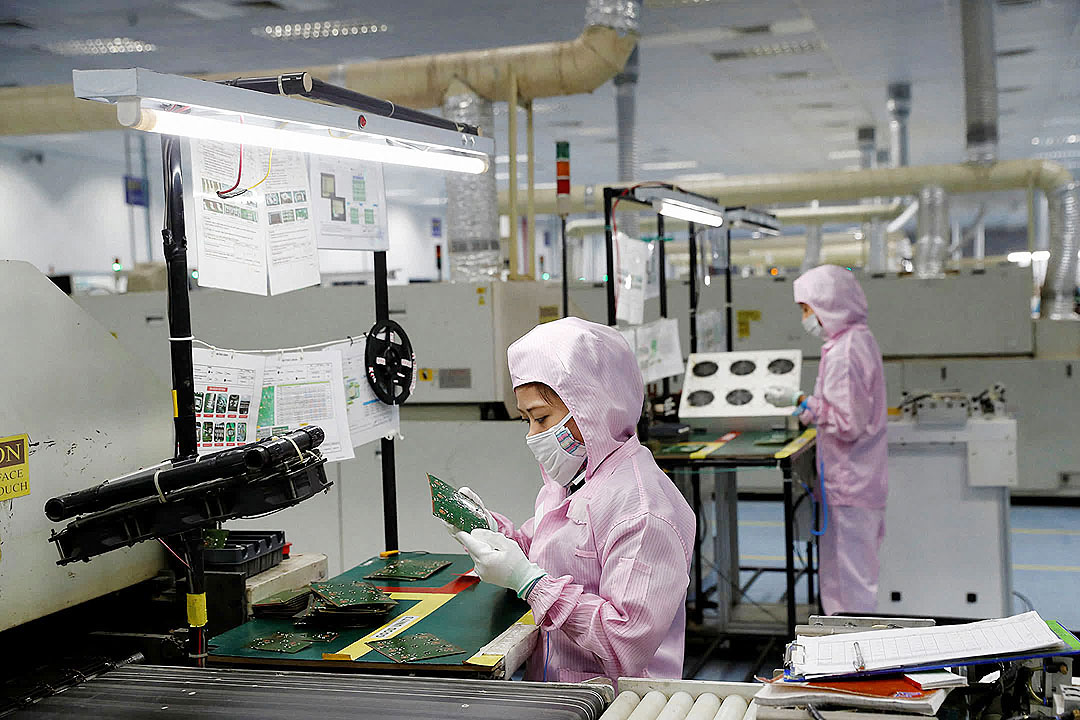Manufacturing growth eases in Dec.

By Bernadette Therese M. Gadon, Researcher
FACTORY PRODUCTION grew at a slower pace in December but remained in the positive territory for the ninth straight month despite the supply chain disruption in the aftermath of Typhoon Odette.
Preliminary results of the Philippine Statistics Authority’s Monthly Integrated Survey of Selected Industries (MISSI) showed factory output, as measured by the volume of production index (VoPI), went up by 17.9% year on year in December.
This was slower than November’s revised 25.8% growth and a turnaround from the 14.8% contraction recorded in December 2020.
December was the ninth consecutive month that the VoPI remained in the positive territory or since April’s 152.1% surge.
This brought average factory output growth last year to 50.3%, reversing the 40.5% decline in 2020.
The PSA attributed December’s growth to year-on-year increases in half of the 22 industry divisions, led by manufacture of wood, bamboo, cane, rattan articles, and related products which jumped by 122.6%.
Other industries that showed growth included machinery and equipment except electrical (to 50% from 40.7%), electrical equipment (49.6% from 44.9%), and coke and refined petroleum products (47.6% from 84.8%).
Meanwhile, the following industries registered declines in December: basic pharmaceutical products and pharmaceutical preparations (-30.2% from -10.5% in November), beverages (-14.6% from -0.8%), and tobacco products (-14.5% from -20.4%).
In comparison, IHS Markit’s Philippines Manufacturing Purchasing Managers’ Index (PMI) slightly increased to a nine-month high of 51.8 in December from 51.7 in November. A reading above 50 marks an improvement for the manufacturing sector while anything below indicates deterioration.
The capacity utilization of these factories averaged 67.3% in December, slightly down from 67.8% in November. Of the 22 sectors, 20 averaged a capacity utilization rate of at least 50%.
Analysts said December’s growth was due to base effects after factory production nearly grounded to a halt in 2020 amid the strict lockdown restrictions imposed to contain the spread of the coronavirus disease 2019 (COVID-19).
“Base effects appear to still play a part in the recent report with the recovery magnified from the sharp fall in the previous year. In the coming months, we do expect these growth rates to moderate further but remain in expansion as the economy reopens gradually,” ING Bank N.V. Manila Senior Economist Nicholas Antonio T. Mapa said in an e-mail.
Security Bank Corp. Chief Economist and Assistant Vice-President Robert Dan J. Roces said in a separate e-mail interview that December saw most economic sectors perform strongly, thanks to the further relaxation of mobility curbs in Metro Manila and other parts of the country.
“December was a strong month for most of the economy with mild community quarantines and above pre-pandemic mobility, and the slower output may be attributed to some effects coming from Typhoon Odette but also due to a slight seasonal pullback,” he said.
In a Viber phone interview, Philippine Chamber of Commerce and Industry (PCCI) President George T. Barcelon said that the easing manufacturing growth seen in December is “normal.”
“People don’t want to carry too much inventory moving into the new year,” Mr. Barcelon said. He added that the supply chain has not yet stabilized, noting that incoming shipments of raw materials were disrupted.
In mid-December, Typhoon Odette (international name: Rai) swept through parts of the Visayas and Mindanao, leaving damage to agriculture and infrastructure worth P13.3 billion and P17.19 billion, respectively.
For January, analysts are looking at a modest output, due to the reimposition of tighter restrictions amid the surge of the Omicron variant in the country. However, they expect manufacturing to pick up again by February.
Metro Manila and other areas were placed under Alert Level 3 in January, but are currently under a looser Alert Level 2.
“The Omicron surge in January may have only a modest impact on manufacturing activity and we expect a quick recovery by February as mobility restriction have been relaxed somewhat,” Mr. Mapa said.
“For January, it was reported that the manufacturing sector’s output and new orders contracted given the resurgence of Omicron as well as the lingering impact of Odette, on top of remaining raw material shortages that led manufacturers to raise selling prices thus the MISSI in January may show that underperformance,” Mr. Roces said.
Manufacturing PMI reading in January hit the 50 mark that denotes no change from previous month. IHS Markit traced this to Typhoon Odette’s aftermath as well as the fresh surge in COVID-19 cases.
“For February, we expect manufacturing to revert to an uptrend on the back of a pickup in manufacturing activity as mobility improves given the easing of quarantine restrictions in the capital region and as the sector’s capacity utilization expands amid a deceleration in coronavirus new infections,” Mr. Roces added.
Mr. Barcelon said he views this year with “guarded optimism,” hoping new COVID-19 cases will continue to drop.
The Department of Health reported 3,574 new cases on Feb. 8, bringing the total coronavirus cases in the country to 3.62 million. Active cases, meanwhile, were tallied at 105,550.
“Sa ngayon, pababa ng pababa ’yung infection eh so that’s a good thing. Pero kailangan ma maintain natin hanggang umabot ng middle or end of February and if that is sustained at a lower rate, that is good (At present, new infections have trended lower so that’s a good thing. But we still need to maintain this until mid- or end-February and if that is sustained at a lower rate, that is good),” Mr. Barcelon said.




